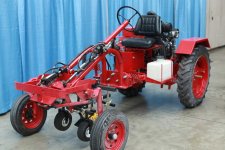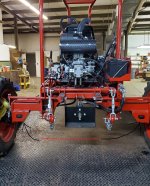You are using an out of date browser. It may not display this or other websites correctly.
You should upgrade or use an alternative browser.
You should upgrade or use an alternative browser.
Electric Tractor
- Thread starter Girma
- Start date
Depends on what you are want to use the tractor for.
Why not go for a motor that connects to the original gearbox?
I think it will be cheaper and better for various load and tourqe demands.
Hub motors will have not enough tourqe for slow speed jobs
Why not go for a motor that connects to the original gearbox?
I think it will be cheaper and better for various load and tourqe demands.
Hub motors will have not enough tourqe for slow speed jobs
DominikDepends on what you are want to use the tractor for.
Why not go for a motor that connects to the original gearbox?
I think it will be cheaper and better for various load and tourqe demands.
Hub motors will have not enough tourqe for slow speed jobs
Thank you for the response. I would like to provide some additional information to clarify our intentions.
The tractor we are working with, the Oggun tractor, currently has a Honda engine with a power output of 16KW. It is equipped with a hydrostatic wheel motor that powers only the two rear wheels. As such, the original tractor does not have a gearbox. The current hydrostatic power train is not efficient and is not delivering the required power due to losses here and there.
Considering the limitations of the existing power train, we think that converting to a fully electric system with hub motors could be a viable solution. What do you think?
How much torque do you need at what speed for how long? (not just power, watts, but actual torque needs--meaning, how hard does it have to push against the ground to do the jobs you need it to, worst case?)I am new for this group. We are working to covert a 25hp diesel tractor to electric. Our plan is to use 4 hub motors to make it 35hp E-tractor. Do you think this is doable?
If you need high torque at very low speeds for long periods, and also high speed capability, you might need two different sets of motors, one wound for high torque at low speeds, and one that is wound for high speeds, and a manual switch or system to autoswitch between them depending on the usage at the time. Each set would have to be capable of the full load of the system under those conditions. There are places like QSMotor that can probably wind any of their motors however you need them to, for the right price.
If you use a high speed motor for low speed high torque it will have a lot of waste heat, and may overheat.
To see how these things work you can play with the simulator at ebikes.ca; it's meant for ebikes but the way things work there apply to any system (and you can use the custom fields to simulate any system up to 2WD, to simulate 4WD you'll need to combine the two rear system needs into one, and the front into one, and use them as 2WD).
Then you will need a controller for each motor, and something to ensure they all operate the same way at the same time (some controllers can interlink for this, most can't).
Then you will need a battery and/or generator system that can supply the worst-case power continuously for the entire length of time the tractor needs it.
Not impossible, but almost certainly very expensive, and will almost certainly weigh a lot more than the original parts that did the same job.
This doesn't include whatever you'll need to do for the rest of the hydraulic systems--if they are run from the original engine, you have to keep that engine or replace it with one still powerful enough to run all those systems. Or you have to replace all the hydraulics with electrics, which is likely to be complicated and expensive. Not impossible, but....
Are you sure about that? Specs say it has both hydraulic steering and hydraulically operated, 3-point lift attachment(s) for implements. Oggún Tractor | Think OggúnIt is equipped with a hydrostatic wheel motor that powers only the two rear wheels.
How do you plan on powering those?
Picturing a big tractor - I'd look into adapting used forklift drive motors for a more affordable option.
Seeing your tractor in the link - Mid drive motors, double stator hubs, auto hub motors.
Nice list to look through - http://www.cnqsmotor.com/upfile/Manual_Software/QSMOTOR_Hub_Motor_Catalog.pdf
Seeing your tractor in the link - Mid drive motors, double stator hubs, auto hub motors.
Nice list to look through - http://www.cnqsmotor.com/upfile/Manual_Software/QSMOTOR_Hub_Motor_Catalog.pdf
Last edited:
eee291
100 kW
I would say he is sure.Are you sure about that?
My issue is with the statement that the hydrostatic transmission is uneficcient. Google will tell you that they are over 90% efficient.
Getting very powerful hub motors adapted would a nightmare, financially and mechanically...
A more realistic solution would be to get slower spinning (higher toque) hydraulic motors.
Attachments
Last edited:
Hillhater
100 TW
Everything on that tractor is hydraulic.. wheel drives (2), steering, 3 point rear lift,front tool lift, rear PTO for powered attachments, and more ,…like pressure hydraulic connections for powering external attachments.
Replacing all that with an electrical based system would be a complete re-engineering exercise and in many cases impossible.
I doubt you can find any hub motor that can produce even a fraction of the torque (pulling power) of that hydraulic drive ..at a realisticly viable price, and the battery+ inverter etc to support it will cost more than a brand new tractor !
Also ,every hydraulic function would need to be replaced by its own individual electric motor/servo together with its own custom control system !
If you really want to electrify this tractor, the obvious and only realistic way to do this would be to replace the Honda ICE with a simple Fork lift DC traction motor, retaining the hydraulic pump and systems.
But You will still need to find space and $$$s for a large battery pack
There are good reasons the commercial etractors are built the way they are..
 solectrac.com
solectrac.com
Replacing all that with an electrical based system would be a complete re-engineering exercise and in many cases impossible.
I doubt you can find any hub motor that can produce even a fraction of the torque (pulling power) of that hydraulic drive ..at a realisticly viable price, and the battery+ inverter etc to support it will cost more than a brand new tractor !
Also ,every hydraulic function would need to be replaced by its own individual electric motor/servo together with its own custom control system !
If you really want to electrify this tractor, the obvious and only realistic way to do this would be to replace the Honda ICE with a simple Fork lift DC traction motor, retaining the hydraulic pump and systems.
But You will still need to find space and $$$s for a large battery pack
There are good reasons the commercial etractors are built the way they are..
e25G Gear | Solectrac | Compact Electric Tractor
The 25 HP Category e25 is a versatile, 4WD tractor, great for hobby farms, golf courses, sports fields, equestrian centers, and municipalities.
 solectrac.com
solectrac.com
Last edited:
You've got me thinking about a battery electric tractor!
I have a very old Farmall Cub. I can visualize an electric motor driving into the manual transmission. The gasser machine can plow a fenched 30 x 30 foot garden with 8hp at the drawbar. And I have a full set of cultivators for it. If someone wanted to grow food this would make it a great market etractor -- and with no hydraulics.I am new for this group. We are working to covert a 25hp diesel tractor to electric. Our plan is to use 4 hub motors to make it 35hp E-tractor. Do you think this is doable?
Hillhater
100 TW
? Plow a 30’ garden ..?The gasser machine can plow a fenched 30 x 30 foot garden
or did you mean somthing more like a 30 yard sq garden ?
Similar threads
- Replies
- 3
- Views
- 790



